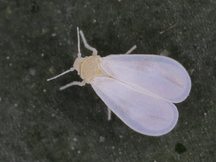Search
About Trialeurodes vaporariorum
Greenhouse whitefly Trialeurodes vaporariorum are found predominantly in temperate regions but have a worldwide distribution. They are known to be vectors for hundreds of plant viruses [1,2], while also being resistant to a number of different insecticide groups. T. vaporariorum are primary insect pests for many agricultural and horticultural crops including fruits, vegetables and ornamental flowers. Adults are ~1.5 mm long but range 1-2 mm in length, white and are said to resemble tiny moths. The wings are a pale yellow, held relatively flat in relation to the leaf surface and are coated with a pure white waxy bloom giving them a 'dusted' appearance.
T. vaporariorum are closely related to another group of important agricultural pests the 'silverleaf whitefly' (Bemisia tabaci). Although less prominent disease vectors relative to Bemisia; T. vaporariorum genomic resources are invaluable to further develop the understanding of insect-arbovirus biology and development of integrated global pest management systems.
Picture credit: Image obtained via Wikimedia Commons. Original image supplied by Dr. Guido Bohne.
Taxonomy ID 88556
Data source Chinese_academy_of_agricultural_science_institute_of_vegetables_and_flowers
Comparative genomics
What can I find? Homologues, gene trees, and whole genome alignments across multiple species.
 More about comparative analyses
More about comparative analyses
 Phylogenetic overview of gene families
Phylogenetic overview of gene families
 Download alignments (EMF)
Download alignments (EMF)
Variation
This species currently has no variation database. However you can process your own variants using the Variant Effect Predictor:





 Display your data in Ensembl Metazoa
Display your data in Ensembl Metazoa

 Update your old Ensembl IDs
Update your old Ensembl IDs

![Follow us on Twitter! [twitter logo]](/i/twitter.png)
